TL;DR
- Backlinks are links from other websites that point to your site. They act as trust signals that improve search rankings and visibility.
- Not all backlinks are equal. Focus on quality, relevance, and authority — not just the number.
- Dofollow links pass SEO value. Nofollow links don’t. Natural backlinks are great. Spammy ones can hurt.
- Internal links improve site structure. External links from credible domains build authority and drive traffic.
- Build backlinks through guest posting, influencer outreach, social media promotion, and broken link building.
- Use tools like Ahrefs and Google Search Console to monitor, disavow toxic links, and manage your backlink profile.
- Backlink strategies like competitor analysis and link reclamation help you gain high-impact links with less effort.
- At Wild Creek Web Studio, we create high-value backlinks with manual outreach, editorial placements, and full audits.
If your website isn’t ranking where it should, there’s a good chance it’s not just about keywords or content; it’s about backlinks.
Backlinks are one of the most powerful (and misunderstood) elements of search engine optimization. They tell Google that your site is trusted, relevant, and worth showing in top search results. But not all backlinks are created equal, and chasing the wrong ones can do more harm than good.
In this guide, you’ll learn exactly why backlinks matter in SEO, how they influence your ranking and visibility, and what separates high-quality, value-adding backlinks from spammy or toxic ones.
What are Backlinks?
Backlinks are essential for SEO success. They’re links from other websites that point to your website, and they act as a vote of confidence in the eyes of search engines like Google.
A backlink is essentially an endorsement. When another site adds a link to yours, it’s telling readers and search engine bots alike that there’s something worth checking out on your page. Backlinks aren’t just about being seen by search engine crawlers; they serve multiple purposes. With every new backlink you get, you also gain social proof with potential customers who may not be familiar with your brand yet.
So, how do these links work? Incoming links (or “inbound links”) tell the search engine what pages have linked to or referenced information on their website. This helps them determine which sites are more authoritative than others so they can prioritise higher-quality content in the SERPs (search engine results pages). It also increases business visibility since searchers will find their content more easily if it has been linked to other sources.
As such, backlinks give companies an edge over competitors who don’t have any incoming links pointing to their web pages, and this could lead to increased traffic, better rankings, and more conversions.
Why are Backlinks Important in SEO?
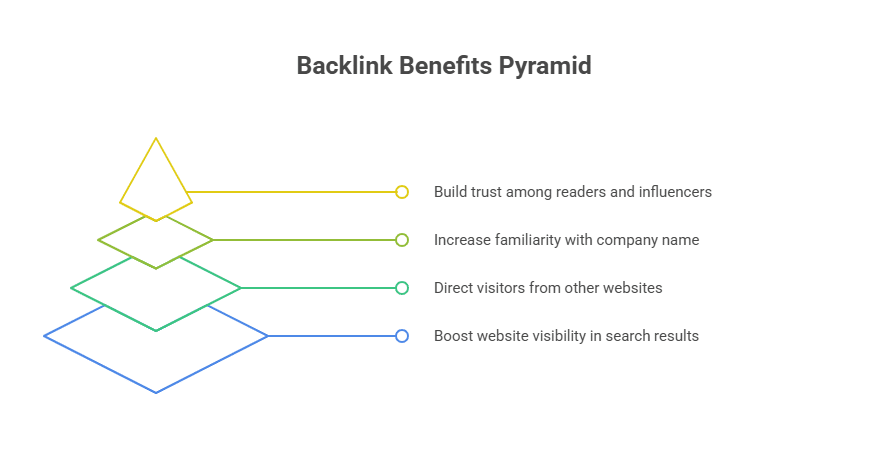
Infographic of Why are Backlinks Important in SEO
Backlinks are a vital part of SEO, and understanding their benefits can help any website owner or digital marketer increase the visibility of their site. Firstly, backlinks allow for improved search engine rankings. Search engines like Google use links to determine the popularity and authority of websites. When other sites link to yours, it tells search engines that your content is valuable enough to be shared with others, thus making it more likely to appear higher in SERPs (search engine result pages).
Key Benefits of Backlinks:
- Boost website visibility in search results
Backlinks signal to search engines that your content is valuable, helping your pages rank higher in SERPs. - Direct visitors from other websites
They drive referral traffic, often resulting in higher engagement and conversions. - Increase familiarity with company name
The more your brand appears across the web, the more recognisable and trusted it becomes, increasing brand awareness. - Build trust among readers and influencers
Backlinks from credible sites enhance your authority and trustworthiness in the eyes of both users and search engines.
What Are the Disadvantages of Backlinks?
While backlinks are powerful SEO assets, not all links are created equal, and some can actually hurt your site more than help it. Here’s what you need to watch out for:
1. Toxic Backlinks Can Trigger Penalties
Links from spammy, irrelevant, or low-quality websites can violate Google’s guidelines. If your backlink profile looks manipulative, you risk receiving manual penalties or algorithmic downgrades in rankings.
2. Unnatural Link Building Can Backfire
Buying links, participating in link schemes, or using automated link generation tools may seem like shortcuts, but they often result in unnatural links that are easy for search engines to detect and penalise.
3. Reputation Risk
Being linked from questionable or controversial websites can damage your brand’s credibility. Users may associate your content with the quality of the referring site, especially if it appears spammy or misleading.
4. Constant Monitoring Is Required
Unlike content on your own site, backlinks are outside your control. You’ll need to regularly audit your backlink profile to identify and disavow harmful links, which takes time and expertise.
5. Short-Term Tactics Can Dilute Long-Term Gains
Chasing quick wins with low-quality backlinks might give you a temporary boost, but it can jeopardise your long-term SEO performance. Sustainable growth depends on relevance, authority, and ethical practices.
What are the Types Of Backlinks?
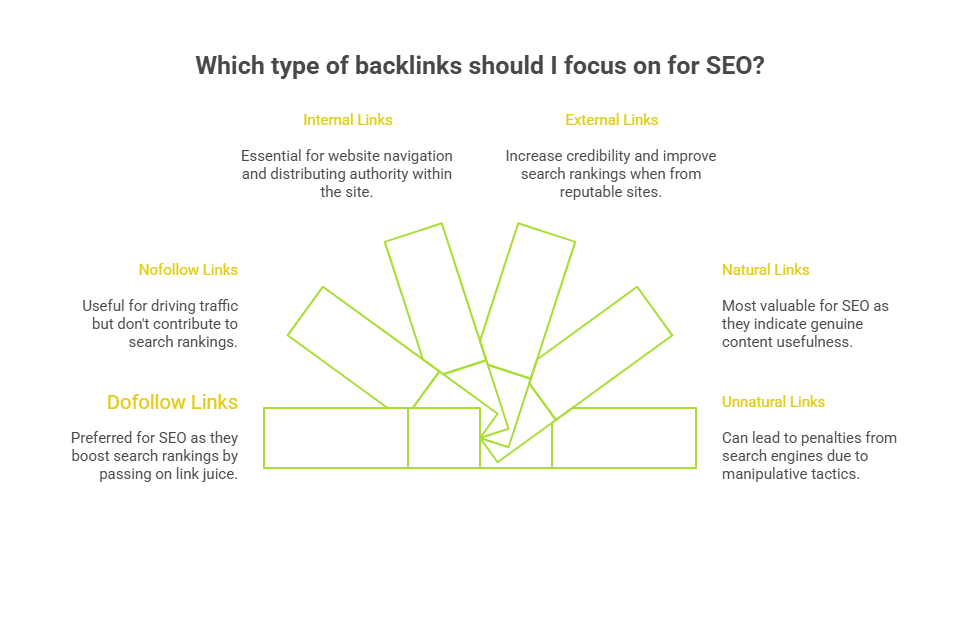
Infographic of What are the Types Of Backlinks
Believe it or not, there are over 200 types of backlinks. Just one in ten links is identified as having a significant impact on SEO rankings. So, when you’re looking to build your link profile, understanding the different types of backlinks and their value is essential.
From editorials and no-follows to sponsored links and affiliate promotions – building quality links should always remain high on your priority list if you’re serious about improving search engine rankings and driving more organic traffic to your site.
- Nofollow vs. dofollow: Nofollow and dofollow are two types of link attributes. Nofollow links don’t pass on link juice or authority to the linked page, while dofollow links do. Dofollow links are preferred for SEO, as they boost search rankings.
- Internal vs. external backlinks: Internal backlinks point from one page on a website to another page on the same website, while external backlinks are links from other websites. Both types are essential for SEO. Internal links help with website navigation and distribute authority, while external links from reputable websites can increase credibility and improve search rankings.
- Natural vs. unnatural backlinks: Natural backlinks are earned organically, without any manipulation or incentivization. They’re the most valuable for SEO as they indicate that other websites find your content helpful. Unnatural backlinks, however, are acquired through manipulative tactics and can lead to penalties from search engines.
What are Internal vs. external Links?
Internal and external links are like two sides of a coin: they have much in common, yet each is distinct. Internal links connect pages within a website, while external links connect to web pages on other websites. Both links can be beneficial for SEO by helping search engines understand the context and relevancy of content, thus improving rankings.
It’s essential to pay attention to internal linking structure; this helps visitors navigate through your site quickly and easily, as well as informing search engine crawlers about page relationships. Creating interlinked silos with relevant anchor text also helps create effective hierarchies that help boost organic traffic. External backlinks from authoritative sites will build trustworthiness for any domain, increasing its ranking potential.
Link building requires strategic planning and careful execution – it’s not just about getting more links but ensuring those you do get to make sense in terms of quality and relevance. It takes research and effort to acquire good-quality backlinks that won’t harm your website or reputation in any way. This means understanding what kind of link exchanges are considered black hat SEO tactics that should be avoided at all costs. With these considerations out of the way, it’s time to start looking into how to monitor and manage links effectively.
How to Create Quality Links?
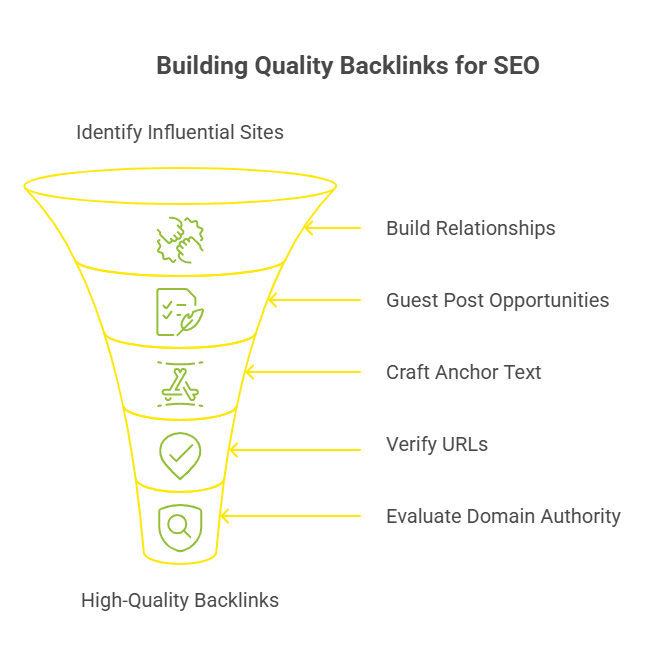
Infographic of How to Create Quality Links
Without high-quality sources, your efforts to drive traffic and rank higher in search engine results will be fruitless. To create effective backlinks, you need to focus on building relationships with influential websites and blogs related to your niche. This means contacting them directly or through social media platforms like Twitter and Instagram. You should also look for opportunities to guest post on relevant sites.
To build backlinks that actually move the needle in search rankings, follow this step-by-step funnel:
- Identify Influential Sites
Start by finding websites and blogs that are relevant to your niche and trusted by their audience. Use tools like Ahrefs, Moz, or SEMrush to check SEO strategy and topical relevance. - Build Relationships
Engage with site owners or content creators via email, social platforms, or thoughtful comments. Relationship-first outreach often leads to natural link opportunities over time. - Guest Post Opportunities
Pitch valuable, original content to relevant websites. Offer topic ideas that align with their audience while giving you a chance to link back to your own content. - Craft Anchor Text
Use descriptive and relevant anchor text that clearly signals what the linked page is about. Avoid generic or keyword-stuffed phrases to keep the link natural. - Verify URLs
Double-check that the destination link works properly, isn’t broken, and goes to a live, crawlable page on your site. - Evaluate Domain Authority
Before securing a backlink, assess the linking site’s domain authority, traffic, and spam score. High-authority sites pass more link equity and credibility.
How to Evaluate the Quality of Backlinks?
When evaluating the quality of backlinks, you’ll want to focus on factors such as authority, relevance, and trustworthiness. Considering these metrics, you can ensure that the backlinks you acquire are valuable and beneficial for your website’s SEO.
Here are four key aspects to assess when evaluating the quality of backlinks:
- Link Authority: It’s crucial to determine the authority of the website that’s linking to you. High-quality backlinks come from reputable and authoritative sources, which can positively impact your website’s authority and search engine rankings.
- Spam Detection: It’s essential to assess the backlinks for any signs of spam or low-quality content. Links from spammy websites can harm your SEO efforts and even result in penalties from search engines. Utilise tools like Google’s Disavow Links tool to identify and remove any harmful backlinks.
- Link Relevance: The relevance of the linking website to your content is another essential factor. Backlinks from websites related to your industry or topic are considered more valuable. They can help establish your website as an authoritative source.
- Domain Authority: Evaluating the domain authority of the linking website can provide insight into its overall quality and trustworthiness. Websites with high domain authority are more likely to pass on valuable link juice to your site.
- Anchor Text Variation: Anchor text should be natural, diverse, and relevant to the content it’s linking to. Overuse of exact-match keywords may trigger search engine penalties.
- Link Placement Within Content: Links placed in the main body of an article are more valuable than those in headers, footers, or sidebars. Editorial links are preferred.
- Indexability of the Linking Page: If the linking page isn’t indexed by Google, it won’t transfer any SEO value. Use tools or a simple “site:” search to verify.
- Website Traffic and Engagement: A backlink from a site with real traffic and user engagement brings both SEO benefits and high-quality referral visitors.
- Follow vs. Nofollow Links: Follow links pass authority; nofollow links don’t. Aim for a mix of both, with a preference for follow links from authoritative sources.
- Content Quality on Linking Page: Ensure the page your link appears on is valuable and well-written. Avoid links from thin, irrelevant, or ad-stuffed content.
How To Monitor and Manage Links?
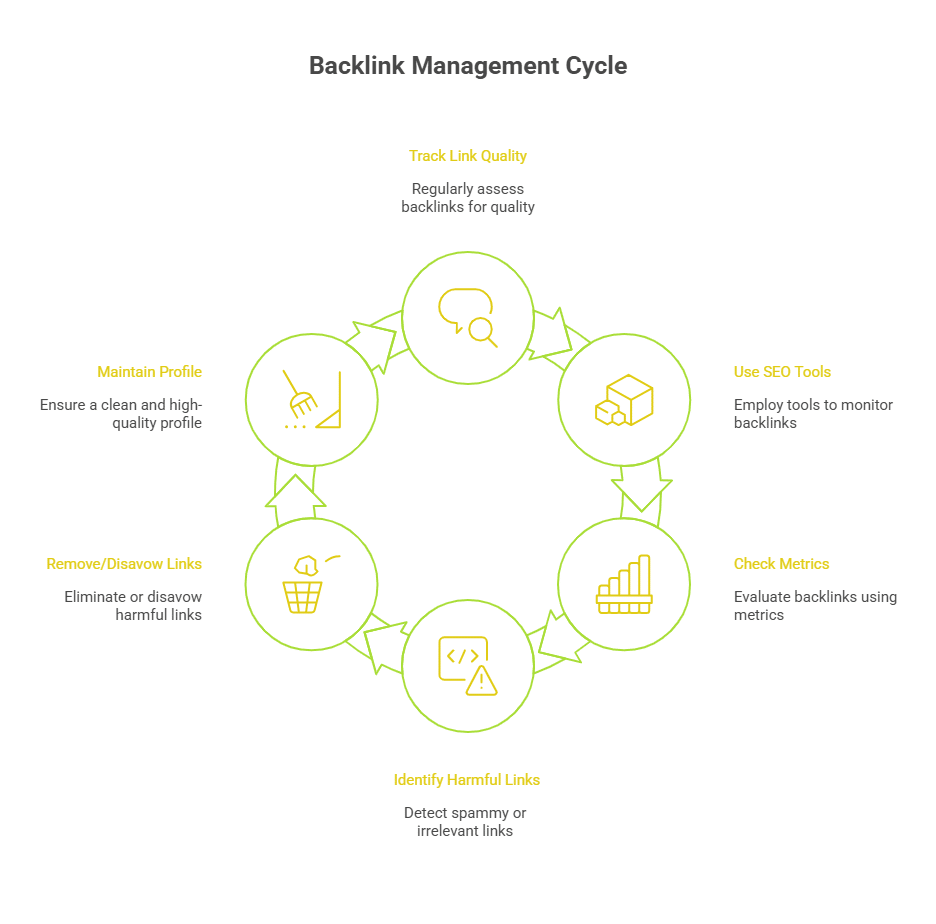
Infographic of How To Monitor and Manage Links
Monitoring and managing your backlinks is key to protecting and improving your SEO performance. Here’s how to stay in control of your link profile:
- Track Link Quality Regularly
The quality of your backlinks directly affects how search engines evaluate your site’s authority and rankings. - Use Reliable SEO Tools
Platforms like Google Search Console, Ahrefs, Majestic SEO, and Moz Pro help you:
-
- See who’s linking to your site
- Identify toxic or irrelevant backlinks
- Monitor link growth over time
- Check Metrics Like DA and PR
Evaluate backlinks using link-building metrics like Domain Authority (DA) or PageRank (PR) to understand how much value each link is contributing. - Identify Harmful Backlinks
Look for:
-
- Links from spammy or unrelated domains
- Sites with high spam scores
- Sudden spikes in links that may look unnatural
- Remove or Disavow Bad Links
-
- Try contacting webmasters directly to remove unwanted links
- If that fails, use Google’s Disavow Tool to prevent those links from affecting your rankings
- Maintain a Clean Backlink Profile
Regularly audit your link profile to keep it aligned with Google’s guidelines and ensure that only high-quality backlinks are associated with your site.
How to Perform Competitor Analysis & Link Reclamation?
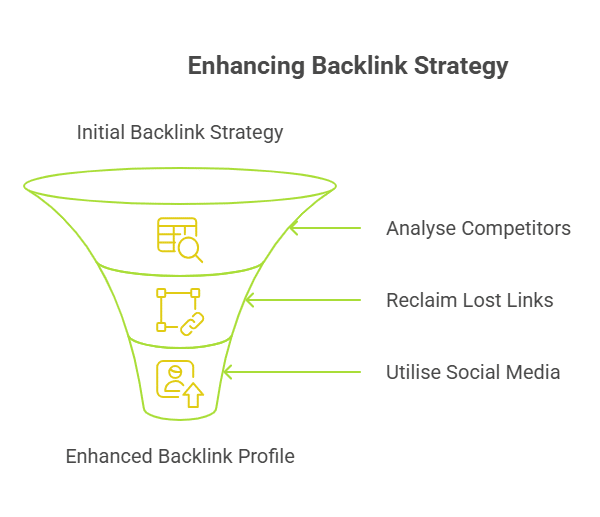
Infographic of Enhancing Backlink Strategy
Now that you know the basics of guest posting and blogging, it’s time to take your backlink strategy further. Competitor analysis and link reclamation are two powerful tactics for building quality links:
- Analyse Your Competition: Identifying who is linking to your competitors allows you to contact those websites as well. By doing so, you can acquire similar backlinks with minimal effort.
- Reclaim Lost Links: If some of your pages were previously linked from another website but aren’t any longer, find out why and try to get them relinked. It could be due to URL changes or simply outdated information on their side – in either case, this provides an excellent chance for further link-building opportunities.
- Utilise Social Media & Directories: Leverage social media platforms like Twitter, Facebook, Instagram, YouTube, etc., as well as local directories such as Yelp and Google My Business to increase visibility and create more chances for people to link back to your site organically.
Let’s Build Your Authority with Strategic, High-Value Backlinks
At Wild Creek Web Studio, we don’t just build backlinks, we build credibility, visibility, and long-term SEO success. With over a decade of experience in technical SEO and digital strategy, our approach goes beyond basic link acquisition.
We focus on:
- Relevance and authority, not just the number of links
- Manual outreach and editorial placements that align with your industry
- Broken link building and link reclamation strategies that deliver lasting value
- Full backlink audits to remove toxic backlinks and strengthen your domain
- Custom link-building campaigns tailored to your niche and business goals
Every link we build serves a purpose, whether it’s passing link equity to your target pages, improving your search rankings, or boosting referral traffic from credible sources. And we back everything with transparent reporting and measurable KPIs, so you always know what’s driving results.
If you’re serious about SEO and want a partner who delivers sustainable, algorithm-safe growth, Wild Creek Web Studio is ready to help.
Get in touch for a strategy consultation.
Conclusion
Backlinks are more than just hyperlinks—they’re one of the most powerful ranking factors in search engine optimization. A strong backlink profile filled with relevant backlinks, follow links, and authority-rich references tells Google your own content deserves to rank higher in search results.
But it’s not just about the number of links. It’s about building the best backlinks that offer real SEO value, connect to your target page, and follow Google’s guidelines. Whether through guest posting, broken link building, or digital outreach, a well-planned link-building strategy plays a crucial role in your overall digital marketing success.
Stay away from toxic backlinks, monitor your performance, and focus on link equity that strengthens your domain over time. Remember—backlink building isn’t a one-time task; it’s a continuous investment in your online credibility and visibility.
Frequently Asked Questions
1. Why do backlinks matter in search engine optimization?
When we discuss in short about seo Backlinks, they signal to search engines that your own content is trustworthy and relevant to a particular topic, making them a major ranking factor in SEO.
2. What makes a backlink valuable?
The best SEO backlink techniques come from authoritative websites, are contextually placed near your target page, and are follow links that pass link equity to your site.
3. What is broken link building?
Broken link building is an SEO tactic where you find dead links on other websites and offer your own content as a replacement, earning a relevant backlink in return.
4. How many backlinks do I need to rank?
There’s no magic number of links, but a diverse backlink profile with high-quality, relevant backlinks will always outperform a large volume of toxic backlinks and that is how backlinks help seo.
5. Can backlinks hurt my website?
If you are wondering, are backlinks important for seo and can they hurt your ranking, then, Yes. If your site receives spammy or toxic backlinks that violate Google’s guidelines, it can harm your rankings. Always focus on ethical backlink building practices.
